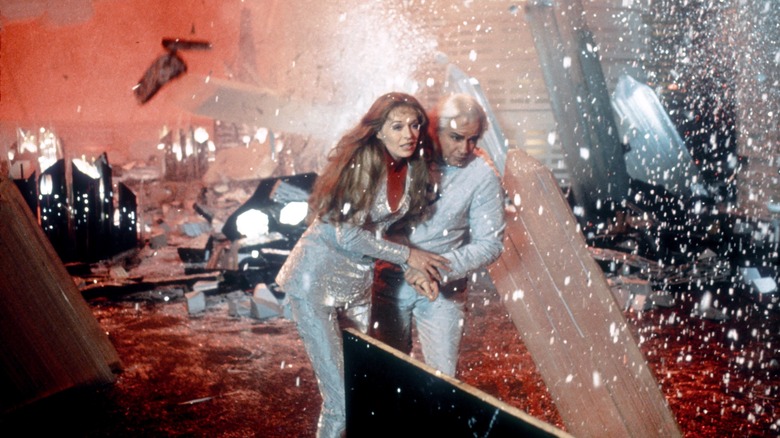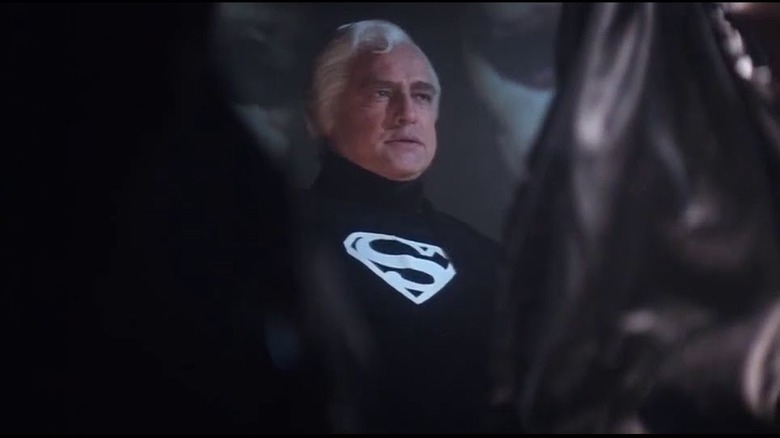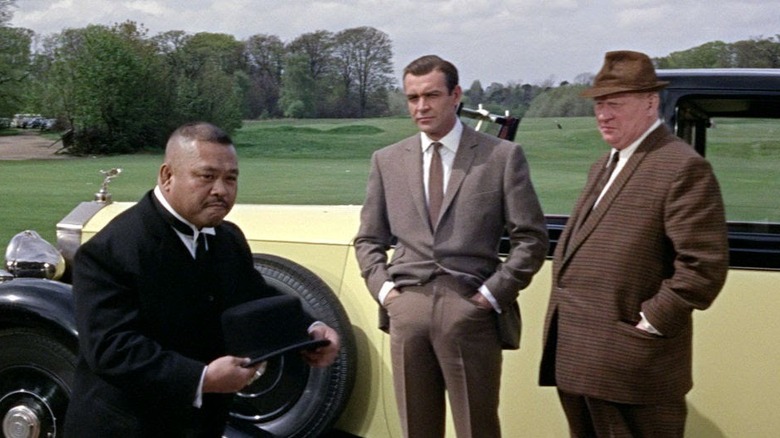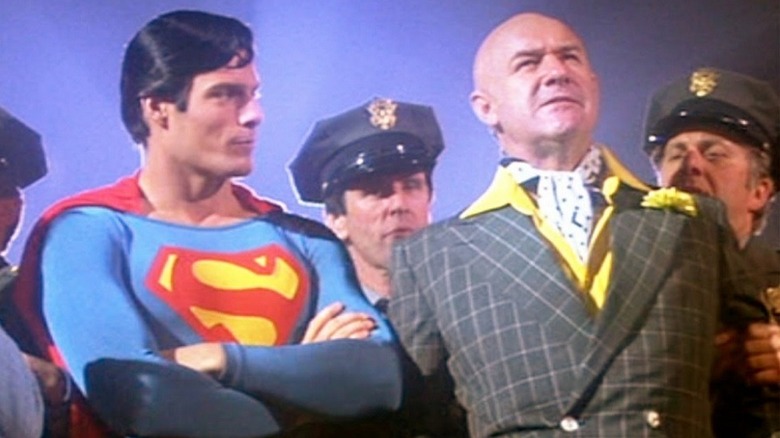Everywhere Superman Wanted To Film, Marlon Brando And Guy Hamilton Were Banned
Established during the early heyday of motion pictures, the "star system" is an informal rule of thumb that most movie producers still swear by, even though the elements of a film's package deal in order to get a green light and raise funds have changed in the last 20-odd years. Nowadays, while having an actor with an established fanbase or persona is still a boon to getting a project off the ground, Hollywood is awash with risk-averse producers using an IP to get a movie made — and that IP is usually comic-book superhero material.
Arguably the film that started Hollywood on this superhero-saturated path, 1978's "Superman," was ironically far from a sure-fire hit when producers Pierre Spengler, Alexander Salkind, and Ilya Salkind were attempting to put it together. Since the Superman character himself wasn't enough to raise the money, the production needed an established star and a seasoned director.
As Spengler and the Salkinds would soon discover, finding the right combination of such people would be a task worthy of Kal-El; their initial choices of star Marlon Brando and director Guy Hamilton would be complicated by the fact that both men were banned in various countries at the time due to a set of circumstances, issues that almost meant "Superman" would never get off the ground.
Brando's Last Tango in Italy
One of the places "Superman" was looking to shoot was in Italy, however as explained in a 2018 Variety piece by Tim Gray, "The producers couldn't film in Italy due to Brando's legal troubles there, centering on the then-scandalous 'Last Tango [in Paris]'."
Gray's choice of words describing "Last Tango in Paris" as "then-scandalous" are either pointed or willfully ignorant, as the 1972 Bernardo Bertolucci film became embroiled in a new wave of controversy in 2016, where during the #MeToo movement an interview with Bertolucci was posted regarding the unethical and criminal way the film's rape scene had been shot. The footage of the director describing his and Brando's actions, coupled with comments from actress Maria Schneider years earlier, caused "Last Tango's" scandal to begin anew.
However, the film had been embroiled in other issues contemporaneous with its release. During the mid-'70s in Bertolucci's native Italy, the film, its director, and stars were part of a criminal case regarding the picture and its alleged obscenity. "Last Tango" was banned in Italy, and so was Brando, effectively. It was this issue that kept him from being able to work in that country, and forced the "Superman" production to look elsewhere.
Hamilton's status as a tax exile changes the fate of Superman — and the Bond franchise
In the mid-1970s, there was no template for superhero fare beyond the intentional comedy of the 1966 "Batman" TV series and a handful of cartoons intended for children. Yet the style and influence of comics on cinema was slowly starting to emerge, especially in Europe with the likes of Roger Vadim's "Barbarella" and Mario Bava's "Danger: Diabolik," which were both live-action adaptations of comic characters.
So the Salkinds and Spengler turned to the closest larger-than-life action hero who they thought would be a good fit for the "Superman" tone: James Bond. While a handful of English directors had helmed entries in the Eon Productions series, filmmaker Guy Hamilton had made one of the most beloved installments ("Goldfinger") while smoothly introducing a new actor, Roger Moore, into the role with "Live and Let Die."
Thinking they'd found their director, the Salkinds and Spengler decided to pivot from Italy to England after discovering Brando's banishment issue. Yet they hit another snag: Hamilton couldn't film in Britain "because of his status as a tax exile in the nation," which meant that he would only be allowed in the country for 30 days and no more.
Unfortunately for Hamilton, Brando's clout was far larger than his, and the "Superman" team decided to let him go. Hamilton's tax exile status meant that not only would "Superman" be made by someone else, but that he would never direct a Bond film again.
Superman shoots in England, with new director Richard Donner
The Salkinds and Spengler knew that Brando was their biggest selling point for not just "Superman" itself, but the legitimacy of the production as a whole. Brando's casting enticed Gene Hackman to sign on to play Lex Luthor, and the film only grew from there.
Still needing to solve the problem of who would actually direct the film, the producers took stock of who was behind the hit movies that were around at the time, landing upon the veteran television director (yet still nascent filmmaker) Richard Donner, who had just made the horror smash "The Omen." As Donner recalled in 2016, Alexander Salkind called him and said, "I don't have a director and I'll pay you a million dollars." Sure enough, one of Salkind's selling points were his stars, with Donner recollecting how the producer told him "I have Marlon Brando for X number of weeks and I have Gene Hackman, and we start shooting on such and such date."
Donner was instantly sold on the opportunity, and even more motivated once he saw the state of the script, explaining how it disparaged Superman so bad that he "wanted to do it just to defend him." While "Superman" and its production woes were far from over, at least the film was finally able to be made, with no further issues of international banishment.



